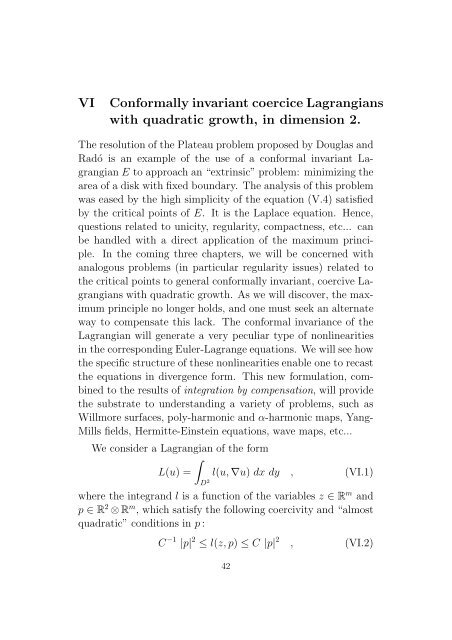Conformally Invariant Variational Problems. - SAM
Conformally Invariant Variational Problems. - SAM
Conformally Invariant Variational Problems. - SAM
Create successful ePaper yourself
Turn your PDF publications into a flip-book with our unique Google optimized e-Paper software.
VI <strong>Conformally</strong>invariantcoerciceLagrangians<br />
with quadratic growth, in dimension 2.<br />
The resolution of the Plateau problem proposed by Douglas and<br />
Radó is an example of the use of a conformal invariant Lagrangian<br />
E to approach an “extrinsic” problem: minimizing the<br />
area of a disk with fixed boundary. The analysis of this problem<br />
was eased by the high simplicity of the equation (V.4) satisfied<br />
by the critical points of E. It is the Laplace equation. Hence,<br />
questions related to unicity, regularity, compactness, etc... can<br />
be handled with a direct application of the maximum principle.<br />
In the coming three chapters, we will be concerned with<br />
analogous problems (in particular regularity issues) related to<br />
the critical points to general conformally invariant, coercive Lagrangians<br />
with quadratic growth. As we will discover, the maximum<br />
principle no longer holds, and one must seek an alternate<br />
way to compensate this lack. The conformal invariance of the<br />
Lagrangian will generate a very peculiar type of nonlinearities<br />
in the correspondingEuler-Lagrangeequations. We willsee how<br />
the specific structure of these nonlinearitiesenable one to recast<br />
the equations in divergence form. This new formulation, combined<br />
to the results of integration by compensation, will provide<br />
the substrate to understanding a variety of problems, such as<br />
Willmore surfaces, poly-harmonic and α-harmonic maps, Yang-<br />
Mills fields, Hermitte-Einstein equations, wave maps, etc...<br />
We consider a Lagrangian of the form<br />
∫<br />
L(u) = l(u,∇u) dx dy , (VI.1)<br />
D 2<br />
where the integrand l is a function of the variables z ∈ R m and<br />
p ∈ R 2 ⊗R m , which satisfy the following coercivity and “almost<br />
quadratic” conditions in p:<br />
C −1 |p| 2 ≤ l(z,p) ≤ C |p| 2 ,<br />
42<br />
(VI.2)
















